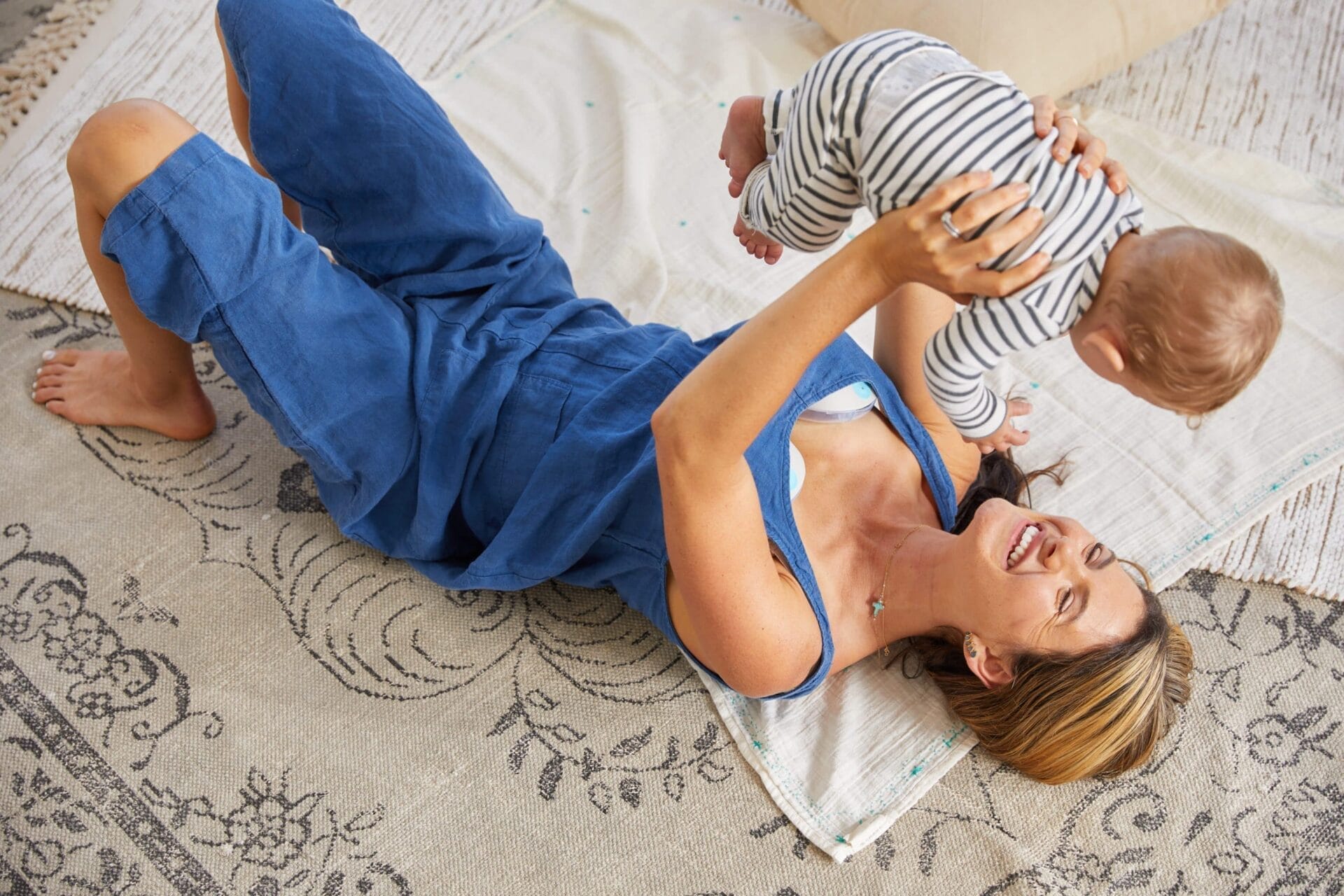We are proud to say that these posts are not sponsored. Our editorial team of Bobbie moms and writers personally select each featured product. If you buy something through our links, we may earn an affiliate commission, at no cost to you.
Babies come with lots of things. There are bottles, bassinets, and burp cloths, but as a mom who’s been there, don’t forget to add a portable breast pump to your list of necessities. Whether you’re exclusively breastfeeding or combo feeding with baby formula, a portable pump gives you the freedom of movement you need when you’re a busy mama to a newborn. If you are trying to finally eat your breakfast at lunchtime, take your toddler to soccer, or run to the office for meetings, a portable breast pump takes care of you so you can take care of your newborn baby. We asked Bobbie moms for their list of the 11 best portable breast pumps, and they answered with excitement. They also told us the hacks they use to add accessories since many of the portable pumps don’t come with the matching parts.
- What is a portable breast pump?
- How do I choose a portable breast pump?
- 11 Best Portable Electric Breast Pumps
- What makes a breast pump portable?
- What is the difference between a manual pump and an electric pump?
- What’s the difference between a portable pump and a hospital-grade pump?
- Do hands-free pumps work?
- Can you sleep wearing a breast pump?
- New hands-free electric pumps are pricey— are they worth it?
- What’s the most common problem noted from the use of a portable breast pump?
- Do portable pumps come with all the pumping accessories?
- Are portable breast pumps safe?
What is a portable breast pump?
Jadah Parks Chatterjee, RN, International Board-Certified Lactation Consultant, and Bobbie Medical Advisor says this type of pump is battery operated, wireless, and designed for you to utilize without hands. A portable breast pump was made for a mom on the go—and let’s be real, what mom isn’t constantly taking care of all the things at all of the times?
How do I choose a portable breast pump?
While choosing a portable breast pump can feel overwhelming, Chatterjee reassures that a portable pump is a nice addition to your feeding journey and most beneficial once your milk supply has been established. She suggests looking for a pump that fits your budget—which includes supplies like phalanges, storage bottles/bags, and cleaning materials. Read on to find the one that’s your “breast fit.”
11 Best Portable Electric Breast Pumps
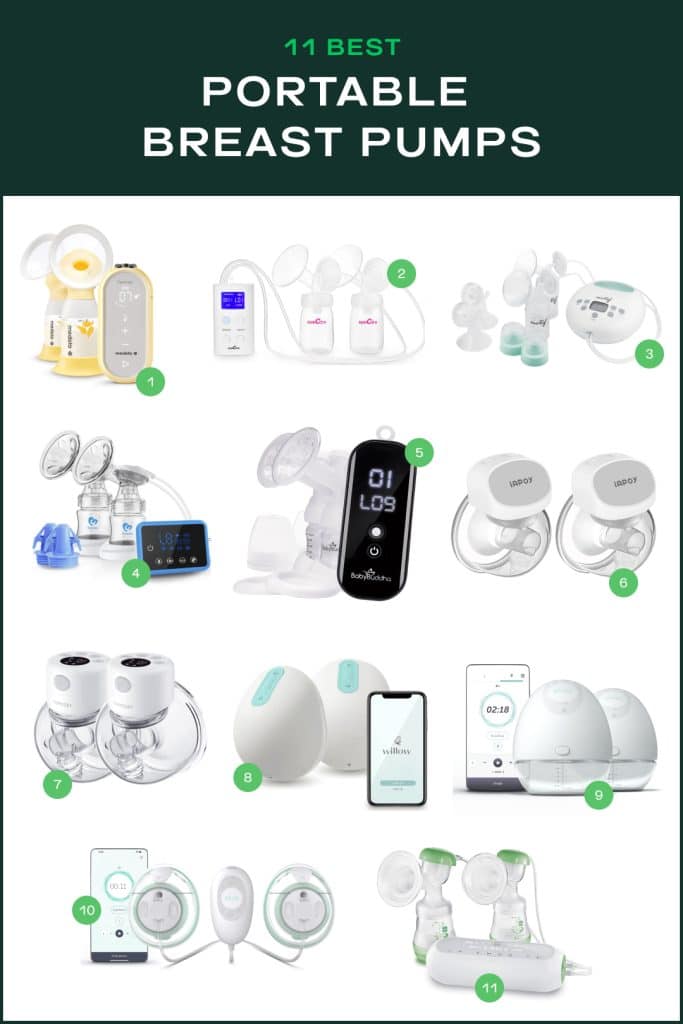
1. Best Lightweight Portable Breast Pump: Medela Freestyle Flex Portable Breast Pump
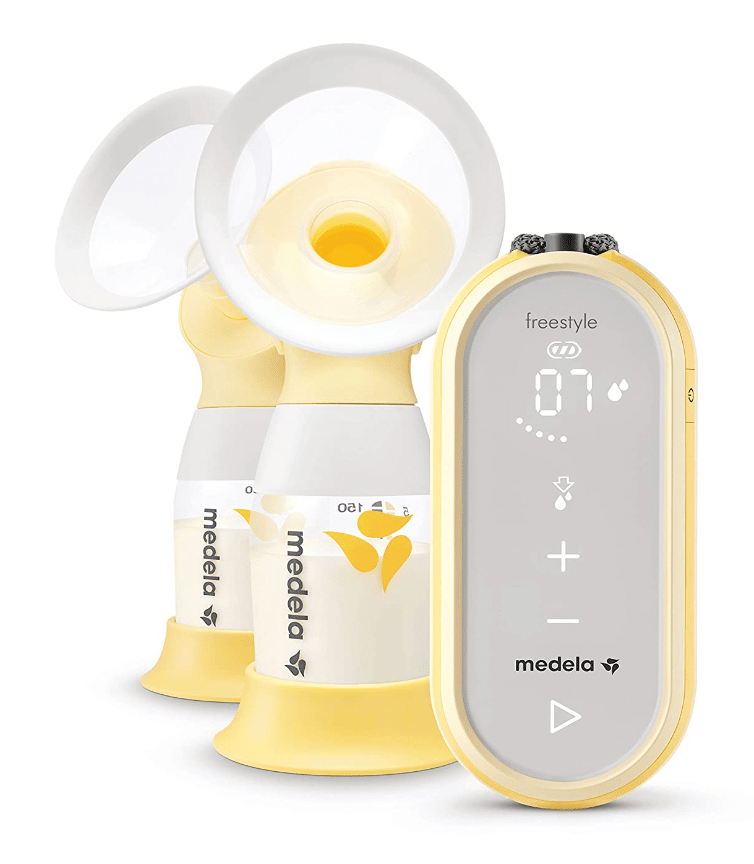
Medela has been a trusted name in caring for moms and babies for over 60 years now. Weighing in at less than a pound, this reliable pump fits in your hand and is designed for daily use and us moms who pump multiple times a day. The rechargeable battery lasts up to two hours and it can also be charged using a USB port. This little, lightweight pump has touchscreen controls and has closed system with overflow protection.
2. Best Portable Breast Pump: Spectra Baby S1 Plus Premier Rechargeable Breast Pump with Grey Tote
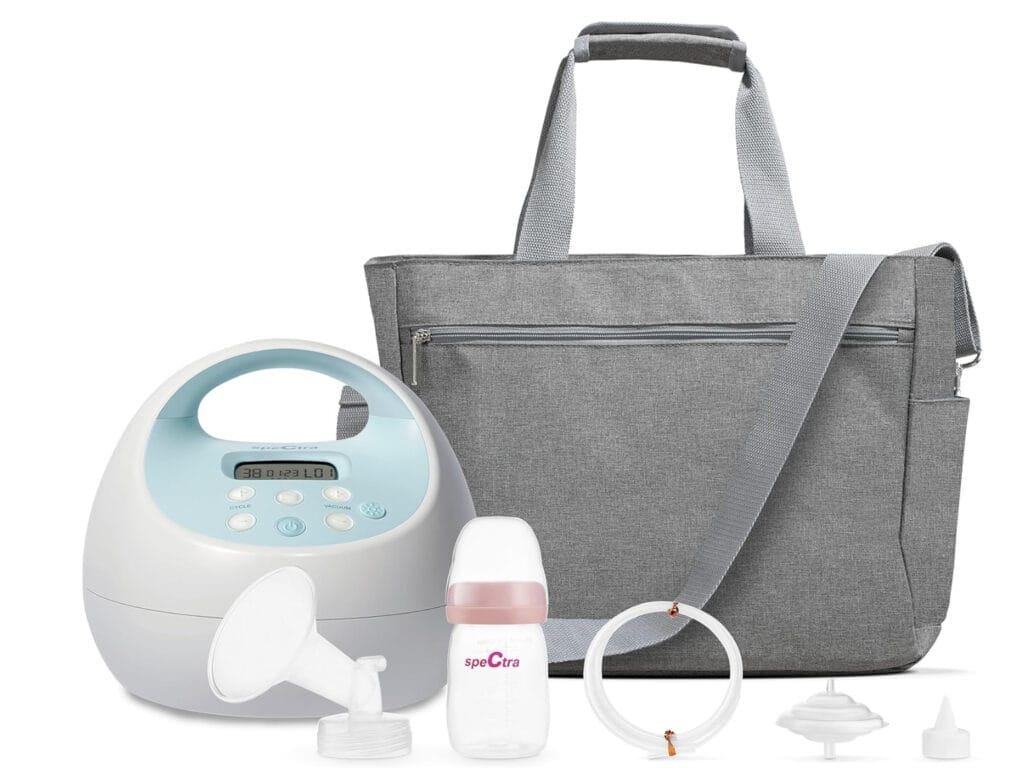
The all in one that pumping moms need, with even the purse to carry it all in! Spectra thought of everything. Good for single or double pumping, the Spectra S1 pump is portable and rechargeable, making it ideal for an on-the-go mom, with the back compartment that fits a Spectra bottle.
3. Best Backflow Protection Portable Breast Pump: Motif Luna Battery Operated Breast Pump
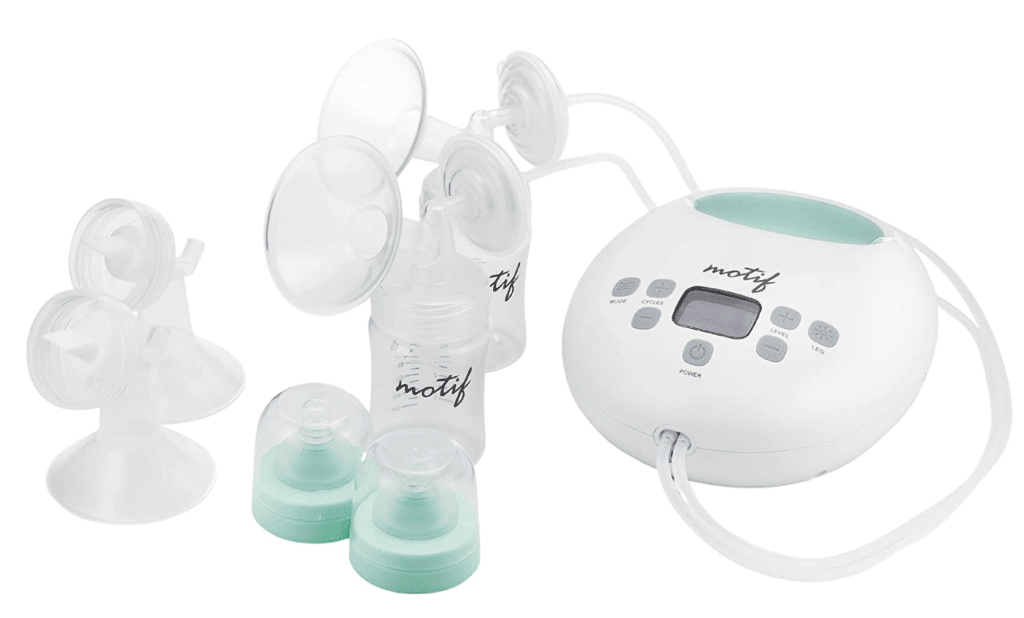
Created by a team of medical professionals, this pump features a rechargeable battery that gives you 2-hours of charge. Weighing close to 2 pounds, it has backflow protection so your milk is always safe, and you’ll feel safer knowing 88% of moms preferred this pump to their current one. It even has a massage mode which helps you stimulate nursing for let-down.
4. Best Budget On the Go Portable Breast Pump: Bellababy Double Electric Portable Breast Pump
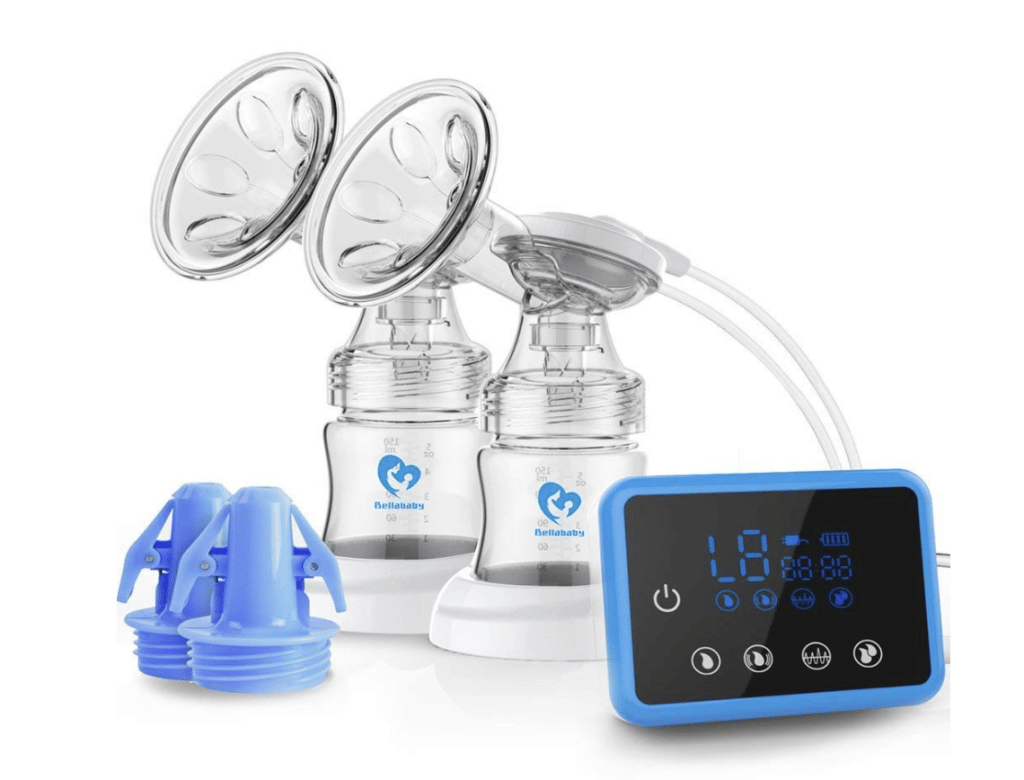
Designed for daily use, this hands-free pump is cost-effective and a super-effective breast pump. Offering you 1-9 suctions levels, you can pump milk directly into bags for easy storage. The timer helps keep you on schedule and the suction range works for anyone along their breast-pumping journey. More than 17,000 moms reviewed this pump on Amazon and gave it a 4+ rating!
5. Best Portable Breast Pump for Sore Nipples: BabyBuddha Portable Breast Pump 2.0

This nursing pump is so small, that the pump can be hung around your neck so you can be completely hands-free. The easy-to-use trackball on the pump allows you to choose your preferred suction mode, and if your nipples have been extra sensitive, worry no longer. This pump “comes with a soft cushion that mimics a baby’s lips.”
Version 2.0 has new features which include:
- New Modes and Settings: In addition to the classic stimulation mode, a new soft stimulation mode provides a gentler experience without the long pull, if desired. With over twenty-one total comfort settings, moms can personalize their pumping sessions.
- Enhanced Efficiency: Equipped with advanced suction technology, the BabyBuddha 2.0 offers increased efficiency, allowing mothers to express milk more quickly and effectively than many other pumps.
- Improved Comfort: Softer materials and an ergonomic design, ensure maximum comfort during pumping sessions.
6. Best Budget Portable Breast Pump: TSRETE Double Wearable Breast Pump
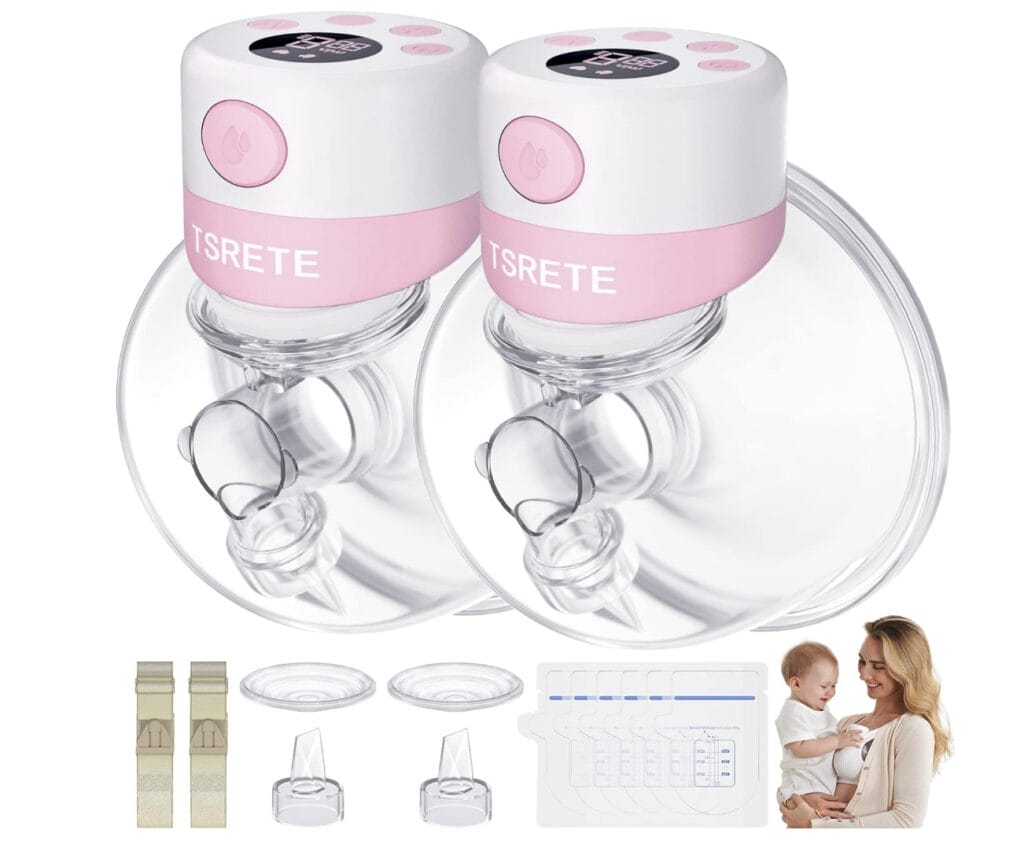
If you’re looking for a pump that has all of the features of the high end pumps without the prices, this is the one! One mom on Amazon says, “I ordered this portable pump and I’m so glad I did. I didn’t want to spend too much money on one and this is probably just as good as the name brands.” We also like the easy to reach LCD screen for easy operation with 9 Adjustable intensity levels, memory function and 30 minutes timer turn off.
7. Best Smallest Portable Breast Pump: Momcozy Breast Pump Hands Free M5
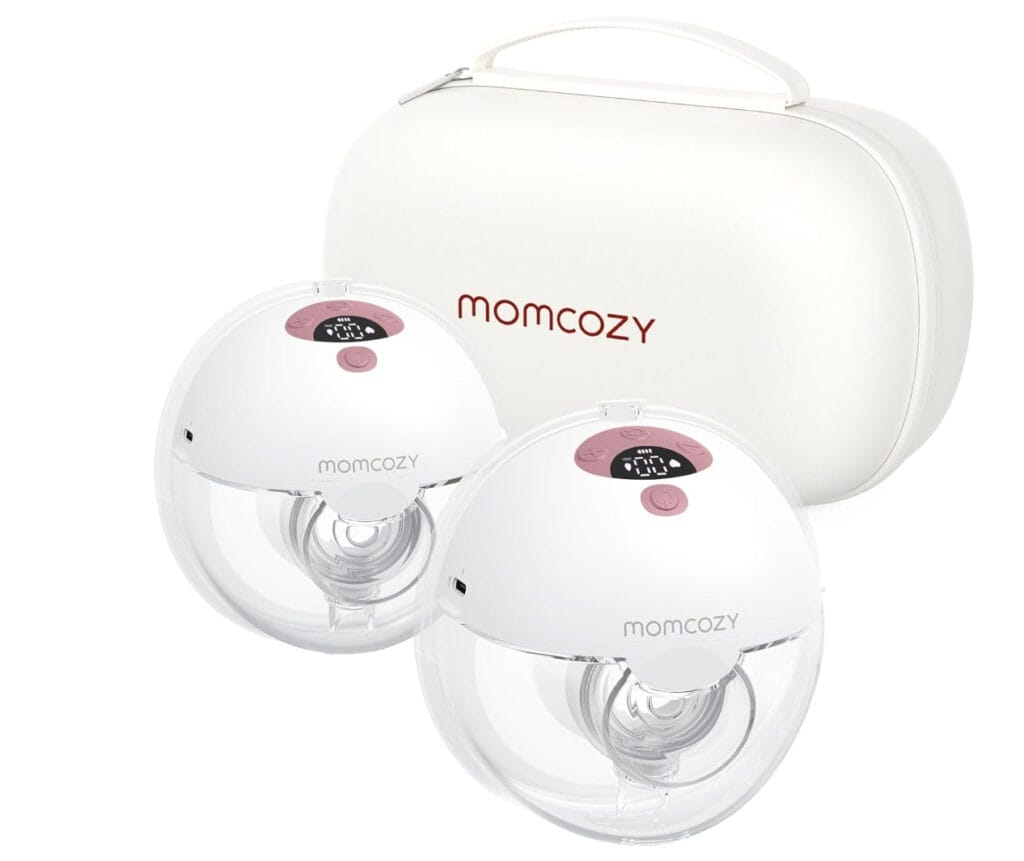
No messy and unorganized cords with this hands-free pump. And it is small! 2/3rds smaller than other brands. With 3 modes and 9 different pumping levels, you’ll be able to find one that works best for you and your milk production. The accessories are made of “soft-food grade silicone” and are way simple to clean, Oh, and let’s not forget the cute packing case and a low noise pump that makes it easy to use anywhere.
8. Best Portable Hands Free Breast Pump: Willow Leak-Proof Wearable Double Electric Breast Pump
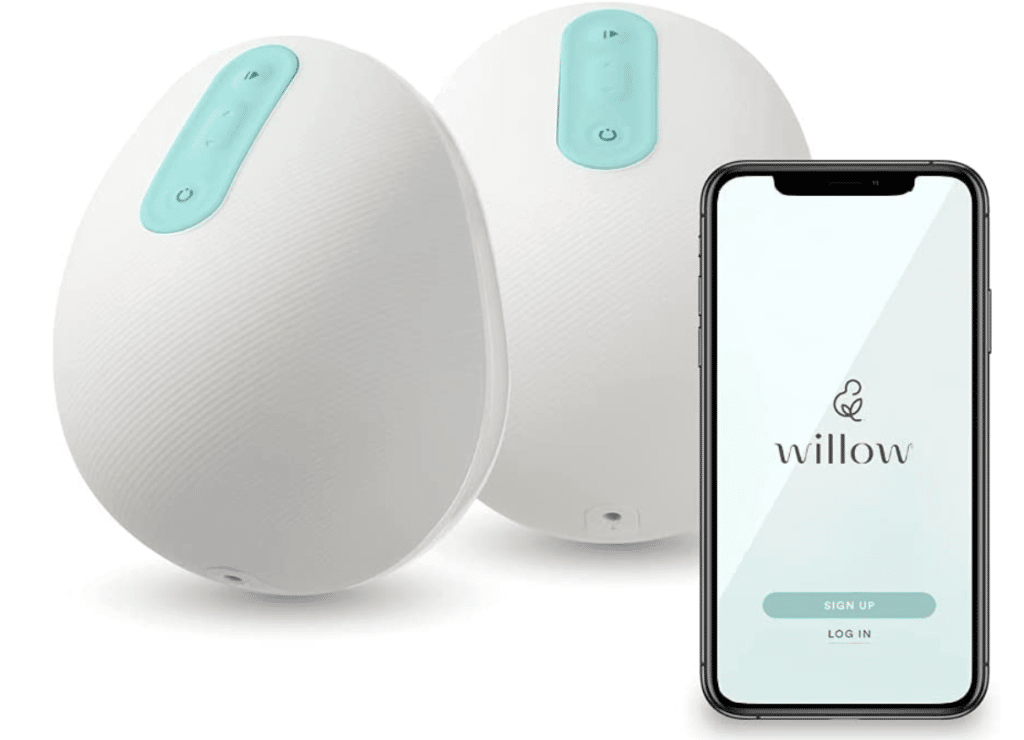
This “all-in-one” pump has no tubes or hanging batteries which means, you have a full range of motion. So, get ready to practice your yoga handstands while pumping—no joke. Willow offers moms two ways to pump: With reusable containers or spill-proof, self-sealing bags—and they mean spill-proof. With 7 different pumping levels, the Willow is the real deal for moms needing maximum freedom and many energizing handstands.
9. Best Silent Electric Breast Pump: Elvie Wearable Electric Breast Pump
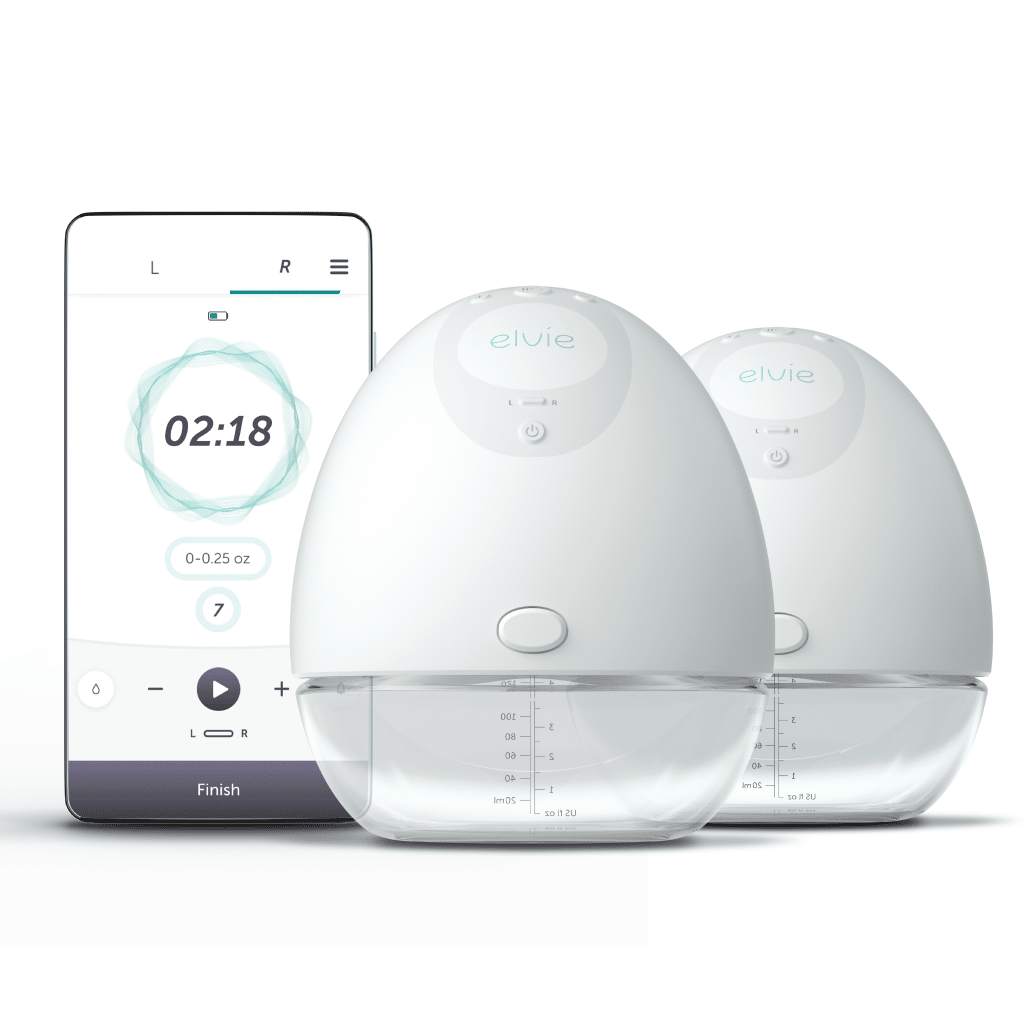
Elvie Pump is a silent, wearable electric breast pump designed to discreetly slip into your bra. Featuring an all-in-one design without cords or wires, Elvie Pump allows you to pump wherever, whenever. Controlled through your phone for the most seamless experience, Elvie Pump is wire-free, hands-free, and hassle-free.
10. Best Hospital Grade Portable Breast Pump: Elvie Stride Breast Pump
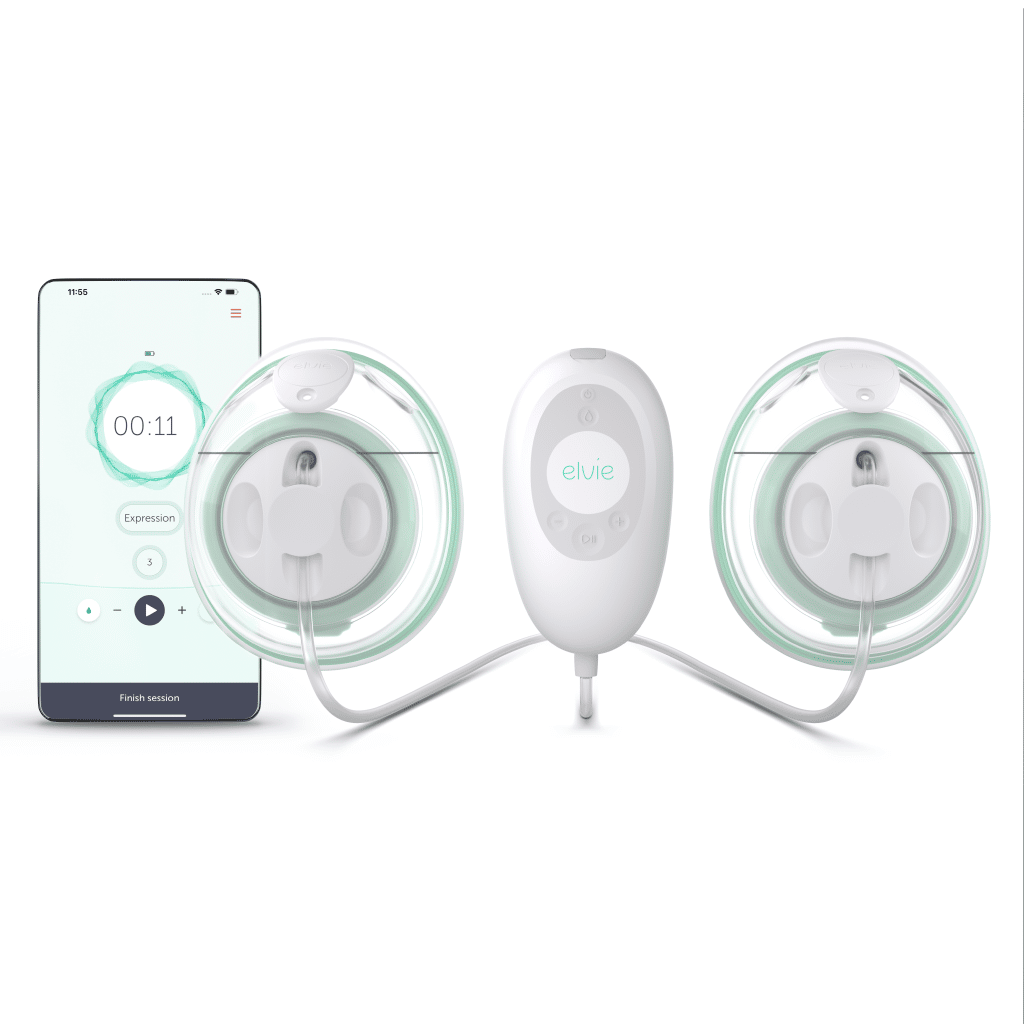
Elvie Stride is a hands-free, hospital-grade performance electric breast pump that is portable, liberating you from sockets and wires. By combining a hospital-grade motor with noise reduction technology, this pumping powerhouse always blends into background noise for true discretion. Elvie Stride feels lightweight and compact and looks natural under clothing while you collect milk in-bra, allowing you to express efficiently wherever you go. Bobbie Mom, Jo, says all her doctors recommend this pump. “Apparently the surgeons here at the hospital use it while they’re doing surgery,” Jo says. She adds that it’s the closest to a hospital-grade pump but without being plugged into the wall.
11. Best Portable Breast Pump Set: MAM 2-in-1 Double Electric Breast Pump and Manual Breast Pump
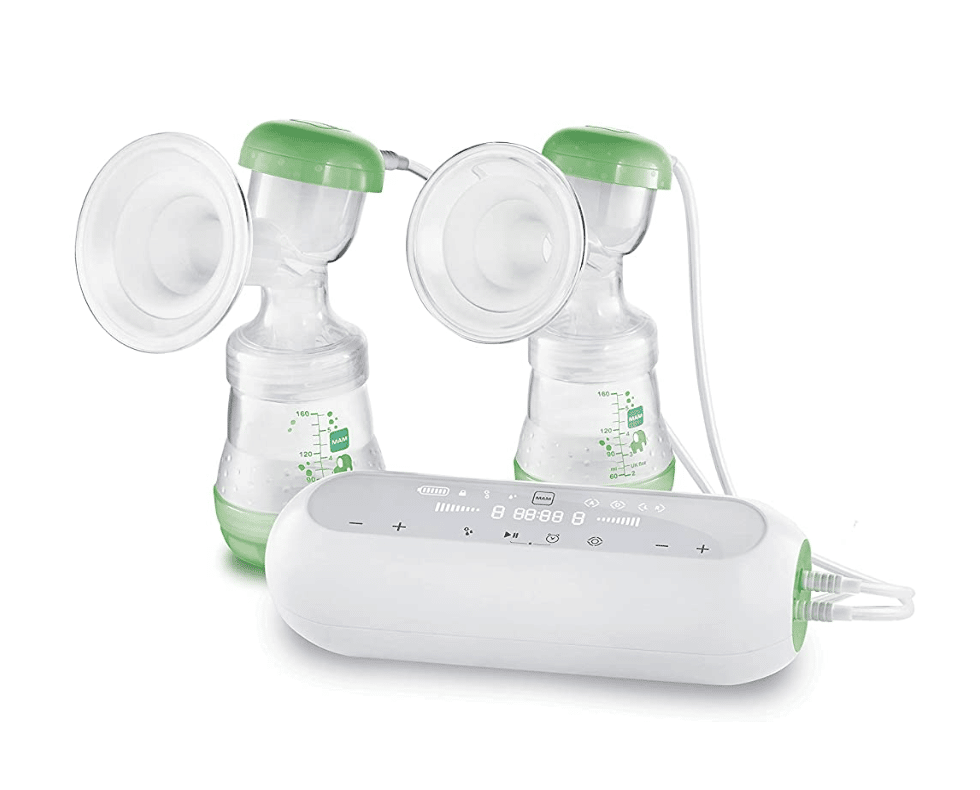
If you aren’t sure which pump type (electric or manual) you’ll need when— have both. With MAM, you can pump simultaneously or alternately on both sides, as well as single pump on only one side. Each side can also be customized to one of the 9 suction levels (expression & stimulation) that is desired. Bonus, this set comes with 2 MAM Easy Start Anti-Colic Bottles and a rechargable battery that lasts for 3 (THREE!) hours.
What makes a breast pump portable?
The defining factor here is that a portable pump provides you freedom of movement. “It doesn’t need to plug into a wall charger during use,” Chatterjee explains. Using a portable pump lets you pump in your car while you’re running errands or when you need to quickly put away laundry during nap time. Chatterjee says what makes the pump portable is the ability to utilize high power, large capacity (lithium-ion) battery or a USB adapter to charge the battery.
What is the difference between a manual pump and an electric pump?
The main difference is that a manual pump works without electricity. These are hand-operated and can only be used on one breast at a time. An electric pump is operated with battery power or by plugging it into a power outlet.
What’s the difference between a portable pump and a hospital-grade pump?
Chatterjee explains that a hospital-grade pump has more power, and more suction/speed functions than most portable pumps— thereby expressing more volume of milk in a shorter period of time. Hospital-grade pumps are cumbersome when packing for an overnighter to grandma’s and need to be plugged into a wall outlet to work. (It should be noted that this is the preferred option for parents pumping to establish and increase milk supply, exclusively pumping parents or parents with babies in the NICU, Chatterjee says.)
On the other hand, portable pumps are lighter, smaller, and have a little less pumping power. “This type of pump is a great option once your milk supply has been established, somewhere around the third/fourth week postpartum,” Chatterjee says. She goes on to say that a portable pump is a fantastic option for road trips, long work commutes, and offer more options for discreetly pumping in public.
Do hands-free pumps work?
Yes, hands-free pumps work! Giving you that flexibility to pump whenever and wherever your pumping schedule decrees (this writer has pumped on a cross-country plane flight), Chatterjee says they’re a great alternative or addition to a traditional electric pump.
Can you sleep wearing a breast pump?
While it may be tough keeping your eyes open when listening to the rhythmic whirring of your breast pump, it’s not recommended to catch some Zs while pumping. Chatterjee says pumps are designed to be utilized for 15-20 minutes and pumping for longer can create discomfort and excessive tension on your nipples and areola. Another reason to stay awake is that not all pumps have spill-proof bags/bottles. A change in posture can cause those to leak or even worse empty completely and Chatterjee adds, “…I know you are not interested in losing even a half drop of milk!”
New hands-free electric pumps are pricey— are they worth it?
Chatterjee says to start with your feeding plan: What’s important to you? How long would like to provide your baby food from your body? Would you like to pump? What’s your next step?
Work with your partner or support team and build a plan that suits you—this includes a financial plan. If it’s definitely part of your feeding plan to be on the go, then Chatterjee suggests placing this gift on your baby registry. “Consider if you purchased the most expensive portable pump, with all the bells and whistles, you’d spend less than $100 a month during the first year of your baby’s life,” she says.
What’s the most common problem noted from the use of a portable breast pump?
Portable pumps have a heap of benefits like freedom of movement, being able to multi-task while making milk, and dealing with a lightweight pump. Chatterjee shares that the most common problems are:
- the power is less than an electric pump
- leaking milk
- short battery life
- the pump phalange not fitting comfortably in the hands-free bra
If you have concerns or questions about engorgement, plugged ducts, and/or mastitis, Chatterjee suggests using a hospital-grade pump. “The stronger suction rate has shown better (quicker) outcomes to resolving excessive milk volume concerns and mitigating things from becoming more concerning,” says Chatterjee.
Do portable pumps come with all the pumping accessories?
While portable breast pumps come with their own parts like breast shields, phalanges, and bottles in which you can directly pump your breast milk, some parts may not be so portable. After all, pumping into a bottle at home sounds great, but if you’re in a meeting or in the park, you’d want to pump into something more discreet that hides under your shirt.
Bobbie mom, Elizabeth, was surprised to learn that the portable electric pump she purchased wasn’t conducive to out-in-the-world pumping. After a friend loaned her some Freemie cups to use instead of her conspicuous bottle attachments, the lightbulb went off. “I bought a conversion kit from Amazon, and that was really when it occurred to me I could pump in more places with cups I could tuck into my shirt,” Elizabeth says. These smaller cups allowed her to pump in public places more discreetly. “Don’t get me wrong, between the tubes and the sound of the pump motor it was obvious what I was doing. But I didn’t feel exposed at all,” she says.
If you feel your portable pump isn’t quite as portable, Elizabeth suggests searching out conversion kits and generic pump parts on places like Amazon. To this point, Bobbie mom, Shira, assures us that many people have successfully figured out this pumping part problem. She says that Google is your friend when it comes to searching out resources for pumping hacks, and that there are also great CLC (Certified Lactation Counselor) led Instagram accounts like @bemybreastfriend that can help. And Elizabeth reminds us it’s worth checking with your HSA/FSA provider because supplies for pumping are generally reimbursable.
Are portable breast pumps safe?
When considering that these pumps attach themselves to a super sensitive area, Chatterjee assures us that portable pumps are safe enough to use throughout your breast-pumping journey.
A portable pump can be packed up quickly in a diaper bag so you can stick to your pumping schedule when out and about or while trying to get your toddler to eat his carrots at home. It’s a wonderful way to support your desire to keep your kiddo fed while keeping up with a life that isn’t slowing down anytime soon.

